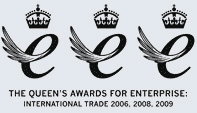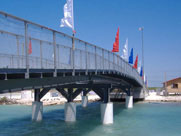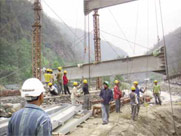Glossary of Steel Bridge Terminology
AASHTO: The American Association of State Highway Organisations, the body which sets the bridge loading codes in the US. The AASHTO codes are used in many other places.
Abutments: The structures in the ground at either end of the gap of the bridge which carry the vertical and horizontal loads from the steel bridge structure.
Aquaduct: A bridge carrying a waterway.
Bailey Bridge: is a portable pre-fabricated truss bridge and is based on a design by Sir Donald Bailey, of Christchurch, during the Second World War. 'Bailey' is now made in lighter form for sale to the civil temporary bridge market. See equipment bridging below.
Beam bridge: Bridges where beams, usually underneath but sometimes on the sides, carry the loads across the span. Beam Bridges can be single span, or multi-span, or continuous multi-span. The deck spans between the beams; or between transom beams which themselves span between the beams. The Bridge Decking can be reinforced concrete poured onto lost-decking formwork; or can be precast panels bolted or grouted into place; or can be steel durbar decking.
Bearings: The fastenings at the places where the main load carrying members (beams or trusses) touch down on the abutments or piers. These are usually intended to allow some movement, including rotation and expansion or contraction. They may be elastomeric, made of hard elastic compressible flexible material bonded to steel plates above and below, or they may be real steel pins, able to rotate but not move horizontally. Alternatively they could be Steel Bridge Rollers, allowing large horizontal movements in one plane.
Bridge Decking: The deck is the surface on the bridge on which traffic can move. The best sort of deck is reinforced concrete. Such decks are usually about 0.25m deep and are heavily reinforced to resist shear and movement between the main beams or the transoms. Such decks are best poured directly onto 'lost formwork'. However reinforced concrete decks are more difficult to remove if the bridge is temporary, or to be re-located. Alternatives are to lock on specially made precast concrete planks; or to use steel decking panels.
BS5400: This is the British Standard for design and construction of Steel Highway and Railway Bridges. The British Standards are widely accepted throughout the world.
Camber: This is the upward curve across the roadway, or along the length of the bridge. Camber is needed to ensure that a bridge deck drains to the sides (or to one side) and does not pond water; there is also a matter of appearance: the bridge deck looks better if it has a slight upward curve along the length, even though this does not affect the strength or durability of the bridge. Unless there is a good reason, bridges should not sag by more than about 1/800 of the span. Packing may be used to get the correct camber. Transoms may be pre-curved to get the side to side camber. Multi-span bridges should not product sharp 'valleys' between spans.
Carriageway: That part of the Deck that includes all traffic lanes, hard shoulders, hard strips, and market strips. The carriageway width is the distance between raised kerbs, if there are any. If there are not, it is the distance inside the guard rails or barriers or safety fences, less the required set back of 0.6m.
Composite beam: A steel beam, which has concrete decking above it, and which is connected to the concrete by shear connectors, which cause the steel and the concrete to act together. Normally the steel will carry the wet weight of the concrete, but when this has set, the two materials will share the load, the concrete mostly acting in compression.
Crash Barriers: These are steel structures designed to prevent vehicles from damaging the bridge if they hit the load carrying members; or to stop vehicles from driving off the edge of the bridge; or to make it harder for vehicles to hit pedestrian traffic on the walk ways.
Diaphragm beams: Steel beams between the main beams which help to share loads between the main beams, and even out deflections.
Durbar decking: This is a type of steel Bridge Decking with a raised profile giving anti-skid properties while still self draining and can be used for walkways or roadways. Often such plates are made into welded panels which can be manually lifted into place and bolted to beams or transoms.
Equipment Bridging: This is pre-engineered bridging, usually from an original military design. Such bridges are made from an assembly of large numbers of standard parts, including panels, transoms, rakers, decking. These bridges are an excellent emergency bridge, and should be held in stock to replace bridges damaged by floods or accidents or explosions. However, they are unsuitable for permanent road bridges: they sag, they rattle, they are too narrow, they do not have crash rails and they are expensive. They should only be used for emergency, and should be taken down and stored for re-use as soon as a proper Road Bridge can be built.
Far bank: The side of the gap to which the bridge spans from the home bank.
Freeboard Bridges: often cross rivers, and the bridge deck should be at some height above the expected flood level.
Gabions: Big baskets of galvanised steel wire, which hold rocks together to stabilise embankments and to reduce erosion.
Gap: The distance between abutments.
Hand rails: These are rails to prevent people from falling off the bridge. They are 1.1m high, and either have vertical rails at 0.11m centres, or infill panels, to make it harder for children to climb them.
Heavy vehicle loading: Most standard loadings allow for an exceptional heavy vehicle. For example a vehicle with 4 axles, each weighing 25 tonnes, at a variety of different spacings, may be applied to a lane of a bridge; the HA loading would be applied to other lanes and other parts of the lane. British Standards would call this 25 units of HB loading.
Highway bridges: Bridges which carry main road traffic.
Home bank: The side of the gap on which construction takes place.
Knife edge load: In standard loadings, as well as the uniform load, a single line load of about is applied at one point anywhere along the lane on that span. British Standards call this HA loading, when used with the lane loading.
Industrial bridges: Industrial processes often need bridges, to carry services, utilities, conveyors or product within, or to and from, industrial plant. REIDsteel can provide these, as part of the building contract or separately.
Lane Loading: The loading is applied as a uniform load to each traffic lane. For this purpose, roadways less than 5m count as one lane, from 5m to 7.5m as 2-lane, from 7.5m to 10.95m as 3-lane, 10.95m to 14.6m as 4-lane, 14.6m to 18.25m as 5-lane. Do not forget that the roadway is 1m less than the distance between barriers. British standards call this HA loading, when used with the Knife edge load.
Military Bridge Classification: Often shown on bridges by a yellow disc, the classification roughly corresponds to the weight of the truck. In some cases, 2 numbers are shown: one with a W, the other with a T. This means Wheeled or Tracked loads.
Navigable height: Some bridges go over rivers used by boats or ships. The clear height needed over the reasonably expected high tide or flood levels is the Navigable Height.
Pedestrian Bridges: Bridges designed mainly for walking traffic, though such bridges are likely to carry cyclists and light motor cycles as well. Such bridges may have stairs and may have ramps. Stairs have to be of the 'public' type with goings of 290mm and even risers of not more than 187mm, and should self drain. Ramps are essential for disabled access and have slopes of 1 in 12; individual slopes should not be more than 10m long between level resting places, and need to be at least 1.2m wide.
Piers: The structures into the ground between the abutments, in the gap, which carry intermediate spans of a multi-span bridge.
Pipe Bridges: Bridges are often needed to carry water or sewage or other utilities across rivers or roads or railways. These utilities can of course be carried on any REIDsteel bridge, or bridges may be specifically designed and constructed for the job.
Rip-rap: The use of large lumps of rock to reduce erosion of the embankment of the roadway.
Road Bridges, Feeder Road Bridges: Bridges designed for minor roads. But the loadings for these are likely to be the same as Highway bridges, especially in remote areas.
Road way: This is the area marked out for vehicles to use the bridge.
Shear connector: These are steel studs which are fixed to the steel beams and around which the concrete deck is poured. They have the effect of making a shear bond between the steel and the concrete, making the two materials act together to resist loads and reduce deflections. They may be pre-welded to the beams using a stud welder, or may be in the form of nuts and bolts which can be fixed on site.
Span: The length of any bridge segment between its structural supports. There may be one, two, or several spans within a gap.
Stayed bridges: Bridges which have the roadway supported at intervals by stays, steel members fixed to the bridge beams at road level, to high up on a tower. The stays may be cables, or rods, or steel beam of column sections bolted together. The towers are then stayed back into large counterweights. There may be towers at both ends of the gap or at one end only.
Steel beams: Steel members of an I shape, which can resist bending, carry tension and compression and shear loads.
Steel columns: Like steel beams, but a squat H shape, which are better at carrying compression loads.
Steel packing: Steel packing may be inserted between the joints of the steel members to ensure the correct shape and camber.
Steel plate web girders: Like large I beams, but made of flat steel plates welded together, then having stiffeners welded into them to keep them the right shape. They may be suitable for major road crossings, especially as continuous beams; but not suitable for export as it is not possible to transport them.
Steel round tubes: Hollow round tubes suitable for compression loads.
Steel square or rectangular box sections: Hollow tubes rolled into square or rectangular shapes, suitable for carrying compression loads; and useful for detailing purposes on handrails etc.
Suspension bridge: A suspension bridge has its deck supported at intervals by cables on either side, hanging in a catenary (or nearly a parabolic) form from towers at either end of the gap. The towers are then restrained by similar cable ties going back to large counterweights in the ground, outside the gap. The cables are usually multi-strand wires bundled together, and need substantial equipment on site to spin them. (A suspension bridge is similar to a Steel Cable Stayed Bridge (see above) except that the suspension cables are smooth curves, rather than a number of straight stays).
Traffic Lanes: These are the lanes marked out for traffic on the roadway. There may be one or more lanes. Lanes should not be less than 2.5m and not more than 3.65m.
Transoms: Steel beams which span under the roadway and carry the loads of the roadway to the trusses or beams.
Truss bridges: Bridges where trusses carry the loads across the span. The roadway may go through, between the trusses (a through-truss bridge) or over the trusses (an over-truss bridge, sometimes referred to as an under-truss bridge).
Truss: Large structures of triangulated steel members which can carry loads aver a span.
Viaduct: A bridge carrying a road or railway.
Wing-walls: The walls either side of abutments which retain the embankment of the roadway and help prevent erosion.










